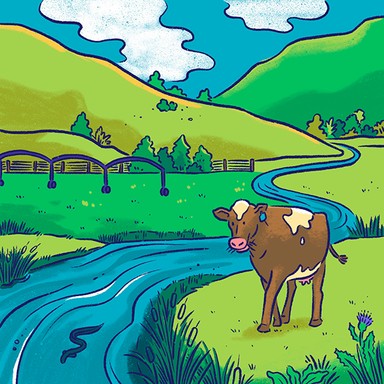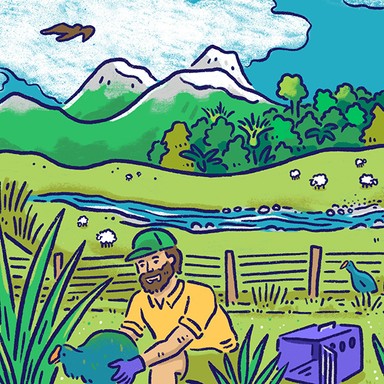
Bay of Plenty Regional Council

Freshwater
The worsening state of New Zealand’s lakes and rivers is a major challenge for regional councils, which play a leading role in managing freshwater in their areas. To this end, regional councils create plans to protect water resources from contaminants and overuse.

Freshwater
The worsening state of New Zealand’s lakes and rivers is a major challenge for regional councils, which play a leading role in managing freshwater in their areas. To this end, regional councils create plans to protect water resources from contaminants and overuse.
Fund the implementation requirements of the National Policy Statement for Freshwater Management and National Environmental Standards requirements with a strong focus on land owner education.
Build a more accurate database via bore metering and river flow metering to better inform water quantity and allocation consenting.
Support and incentivise water use effectiveness and efficiency opportunities.
Advocate strongly to keep local decision-making about water assets out of centralised control as proposed in Three Waters.
Consider wetlands and natural waterflows when creating urban development.
Continue with freshwater improvement and protection while supporting agriculture and horticulture to do so on private land.
Ensure freshwater environmental policies do not hamstring small and holders and farmers.
Maintain water quality and supplies with prudence encompassing future demand, climate extremes, natural and environmental occurrences.
Monitor and act to cope with extreme weather events proving to be commonplace in the evolving climate of the 2020s. Climate fires are a reality.
Adapt and develop effective methods to protect and sustain communities, ecosystem, food production activities and a healthy economy.
Working with landowners across the region to help them reduce pollutants into our streams, rivers and lakes. Protecting our freshwater is key.
Ensure we monitor 90% of swimming sites for water quality and 75% of these sites meet swimmability requirements.
Ensure our water and land management practices maintain and improve the life giving ability of the region's freshwater resources.
Monitor water quality in all waterways in the Bay of Plenty. Implement change based on quality.
Reduce contaminated runoff and polluted storm water. Monitor fertilizer use and farm stock levels.
Maintain plant keep clean and expand the flood catchment areas of the Bay of Plenty.
Improve freshwater quality by better managing pollutants, sediments and microplastics.
Future-proofing and ensuring freshwater quality, quantity and flow managed locally with local expertise.
Transparency of developers' contribution to expanding infrastructure. Improve communication with developers to enable development.
Sustainable co-relationship between urban sprawl and the impact on agricultural land for expanding fresh water supply.
Greatly reduce silt runoff into our harbour from housing development which has not been effectively monitored and enforced in the past.
Continue to support regular monitoring of all streams feeding into the harbour and ocean to achieve swimmable rivers once again for everyone.
Promote greater use of rain water storage in residential and commercial properties so we are not flushing drinking water down our wastewater.
Ensure freshwater is valued and communities understand how to use smart ways to capture, store, use and recycle water.
Work with the agricultural sector to develop integrated approaches to improve water quality and increase biodiversity.
Proactively identify areas for restoration and planting that will provide the best return for freshwater quality and support resilience.
Commit to water quality improvement. We need good science to measure this for ourselves, our children, and our grandchildren.
We need better science to understand water quantity issues. We only use 2% of our rainfall, so we need to be thinking about water storage.
Fund the implementation requirements of the National Policy Statement for Freshwater Management and National Environmental Standards requirements with a strong focus on land owner education.
Build a more accurate database via bore metering and river flow metering to better inform water quantity and allocation consenting.
Support and incentivise water use effectiveness and efficiency opportunities.
Advocate strongly to keep local decision-making about water assets out of centralised control as proposed in Three Waters.
Consider wetlands and natural waterflows when creating urban development.
Continue with freshwater improvement and protection while supporting agriculture and horticulture to do so on private land.
Ensure freshwater environmental policies do not hamstring small and holders and farmers.
Maintain water quality and supplies with prudence encompassing future demand, climate extremes, natural and environmental occurrences.
Monitor and act to cope with extreme weather events proving to be commonplace in the evolving climate of the 2020s. Climate fires are a reality.
Adapt and develop effective methods to protect and sustain communities, ecosystem, food production activities and a healthy economy.
Working with landowners across the region to help them reduce pollutants into our streams, rivers and lakes. Protecting our freshwater is key.
Ensure we monitor 90% of swimming sites for water quality and 75% of these sites meet swimmability requirements.
Ensure our water and land management practices maintain and improve the life giving ability of the region's freshwater resources.
Monitor water quality in all waterways in the Bay of Plenty. Implement change based on quality.
Reduce contaminated runoff and polluted storm water. Monitor fertilizer use and farm stock levels.
Maintain plant keep clean and expand the flood catchment areas of the Bay of Plenty.
Improve freshwater quality by better managing pollutants, sediments and microplastics.
Future-proofing and ensuring freshwater quality, quantity and flow managed locally with local expertise.
Transparency of developers' contribution to expanding infrastructure. Improve communication with developers to enable development.
Sustainable co-relationship between urban sprawl and the impact on agricultural land for expanding fresh water supply.
Greatly reduce silt runoff into our harbour from housing development which has not been effectively monitored and enforced in the past.
Continue to support regular monitoring of all streams feeding into the harbour and ocean to achieve swimmable rivers once again for everyone.
Promote greater use of rain water storage in residential and commercial properties so we are not flushing drinking water down our wastewater.
Ensure freshwater is valued and communities understand how to use smart ways to capture, store, use and recycle water.
Work with the agricultural sector to develop integrated approaches to improve water quality and increase biodiversity.
Proactively identify areas for restoration and planting that will provide the best return for freshwater quality and support resilience.
Commit to water quality improvement. We need good science to measure this for ourselves, our children, and our grandchildren.
We need better science to understand water quantity issues. We only use 2% of our rainfall, so we need to be thinking about water storage.
Mayor
Compare the mayoral candidates in your area
Local council
Compare the candidates for your city or district council
Regional council
Compare the candidates for your regional council
Local board
Compare the candidates for your local or community board






